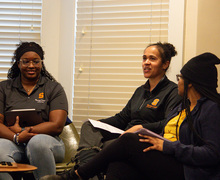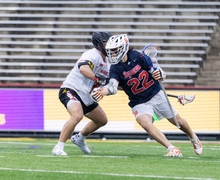Despite SU’s top research status, challenges for researchers mount
Emily Steinberger | Photo Editor
Maintaining a nonprofit research status allows the university to stay current in research trends, which allows more freedom with research initiatives.
Get the latest Syracuse news delivered right to your inbox.
Subscribe to our newsletter here.
After pursuing research as an undergraduate at Syracuse University, Stephen Ajayi chose to stay at the university for his graduate degree. The research that he participated in during his undergraduate years fueled his desire to continue that work.
Ajayi, who’s pursuing a master’s degree in neurobiology, spends about 80 hours a week with his research. But since he’s only paid through his role as a teaching assistant, that research feels like only a secondary responsibility.
“Your research is not really your focus,” Ajayi said. “You’re really getting paid through a teaching assistantship, and to further compound that, they require that you do not work anywhere else.”
SU is one of 131 universities that the Carnegie Foundation for the Advancement of Teaching, a research and educational policy center, has classified as a Research 1 institution, meaning it has “high research activity.” But the university spends less on research per student than others with the same Research 1 classification.
Researchers at SU said their financial troubles as graduate students make their research feel like less of a priority as they struggle to make ends meet.
SU spent $2,823 on research per enrolled student in 2019, while other comparable universities spent more than $10,000 per student, according to data from the Department of Education’s National Center for Education Statistics.

Sarah Jimenez Miles | Design Editor
The reason SU spent less on research than other similar institutions is likely because it doesn’t have a medical or dental school, representatives from the Office of Undergraduate Research said in an email. Having a medical and dental school typically attracts more funding from outside sources, the office said.
“Without a medical school, it’s incredibly challenging to maintain that research 1 status because medical schools pull in so many research dollars,” said Mike Goode, an associate professor of English, in an interview. “It’s actually relatively easy for a university with a decent medical school to have that status.”
SU does not profit from its research, which makes research more expensive, the office said. Maintaining a nonprofit research status allows the university to stay current in research trends, which allows more freedom with research initiatives, the office said.
“Research is not intended to be profitable to the university,” the office said. “The reason that universities continue to do research even though it’s not profitable is because it is an important part of our educational and social mission.”
For some researchers, the pandemic has made research that’s already difficult to conduct even more challenging.
Before the pandemic, Madison Firkey, a third-year graduate student studying clinical psychology, had utilized the SONA research participant pool — which provides students with $1,500 for research or professional development programs — so she didn’t need to find other funding.
“I know this was not an option for some of my peers, and they opted to halt recruitment until the SONA pool reopened in fall 2020.” Firkey said. “Our department has been incredibly flexible and understanding with deadlines to accommodate students who had to take this approach.”
More stories on research at Syracuse University:
- SU pauses in-person research, limits lab capacity
- STEM dominates SU leadership and research, professors say
- SU Libraries looks to aid graduate research
- SU plans to increase research spending to $200 million
When the university transitioned online last spring, the lab Firkey worked at did the same. She was able to utilize her adviser’s start-up funds to cover research expenses, but other students didn’t have that option, she said.
Madison Woodley, a first-year graduate student in the Department of Earth and Environment Science, said that COVID-19 limited normal research experiences.
“I haven’t had as many opportunities to visit my field site, connect with other scientists or get a real taste of what research in my career is like since everything is remote,” Woodley said.
Ajayi works with many undergraduate students in his research labs. When the university shifted to remote learning last year, a number of undergraduates had to leave, he said.
Before the pandemic, many research labs within the department Ajayi works in would collaborate and share equipment. But when students in other research labs test positive or are exposed to the coronavirus, they lose that ability.

SU is encouraging undergraduate students to consider research as early as their first or second year on campus. Emily Steinberger | Photo Editor
“It’s very disruptive in that sense,” he said. “Of course, they had to do that, and I understand completely, but it’s just disruptive.”
SU is encouraging undergraduate students to consider research as early as their first or second year on campus so they have more time to engage in research activities, the Office of Undergraduate Research said.
The office also encourages students from any major or field to participate in research. Depending on the field of study, students may not realize the research opportunities available, the office said.
Goode said he’s worked with students who need help forming research questions and using appropriate databases and archives. Sometimes, there can be a lack of research experiences available in humanities courses, he said.
SU has also looked to increase undergraduate students’ participation through resources available through its Syracuse Office for Undergraduate Research and Creative Engagement, which has funded over 400 students in research since 2019.
The SOURCE office works with other research teams to provide peer mentoring, support faculty mentors and expand undergraduate research participation, the Office of Undergraduate Research said.
Even with these challenges, Firkey and other students find participating in research incredibly beneficial.
“I have expectational colleagues who have helped me shape research ideas from a few disjointed thoughts into published manuscripts, and for that, I am very fortunate,” Firkey said.
Published on March 4, 2021 at 12:12 am
Contact Kailey: kmnorusi@syr.edu






